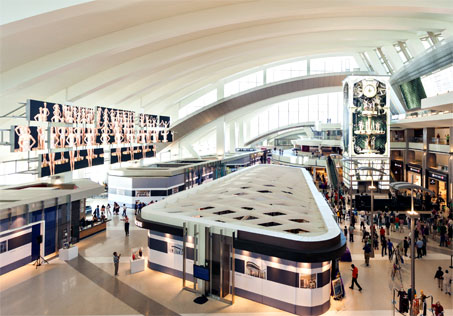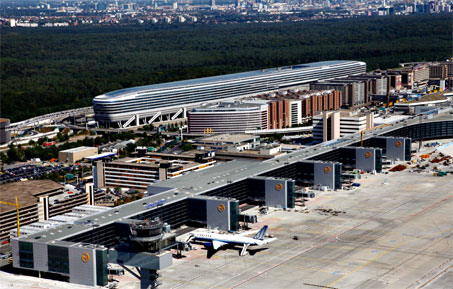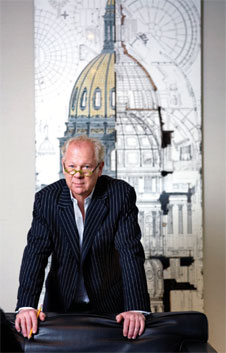
The new Bradley West Terminal at Los Angeles International Airport includes vast digital screens and an 80m-high digital clock tower, which passengers can interact with using their smartphones and tablets. (Photo © Moment Factory.)
Innovative new technologies and materials, a sharper focus on environmental sustainability and the demand of communities for their local airport to reflect the destination itself are three key things that will influence what the future airport will look and feel like.
The remit of airports to simply provide a means of enabling travel from one point to another has long since expired and the modern day passenger now expects a facility that offers a seamless and memorable journey that is part of their overall travel experience.
Curtis Fentress, the architect behind landmark airport designs in the likes of Denver and Incheon, is the pioneer of the airport that has a sense of place, and his latest project – the recently opened Bradley West Terminal at Los Angeles International Airport (LAX) – provides insight into what the future airport will look like.
“We’ve just finished the new terminal at LAX and we’ve been working on that for five years, and making changes on the fly during that time,” he said. “What you will see there are large electronic media screens that are almost a soccer field long and a clock tower that’s 80-metres high. This is all digital and you can dial in and interact with these features through smart devices. The potential is there for all sorts of interactions with the passenger of the future.”
Fentress explained that he expects to see “the retrofitting of screens and interactive devices in almost all airports”, just as he expects each of them to tap into the city and country they serve.
He continued: “At Denver, the inspiration was the Rocky Mountains, in LA it was the waves coming in on the beach from the Pacific Ocean, and at Incheon it was inspired by the Korean home. 20 years ago, what we did at Denver was unique. Since then, we’ve seen a trend of airports and communities wanting something unique and special, and architects have fallen in line with that trend. This is something that will continue because what’s appropriate for Denver isn’t appropriate for New York, and what’s appropriate for Shanghai isn’t appropriate for Sydney. The airport now has to connect to the style of the place.”
A duty to the environment

The Fentress-designed Denver International Airport, with its Rocky Mountains-inspired roof, set a trend of airports reflecting the place they serve. “That’s exactly what architecture is about – creating a sense of place,” explained Curtis Fentress, Principal-in-Charge of Design at Fentress Architects. (Photo © Ellen Jaskol.)
Creating a unique, distinguishable structure is one thing, but just as important is ensuring that the facility is environmentally efficient. This is an approach that is at the heart of Fraport’s extensive development programme, which last year saw the opening of Frankfurt Airport’s Pier A-Plus and will also herald the introduction of a brand new Terminal 3, which is expected to open in 2020.
Laukenmann is a member of the team responsible for ensuring the ongoing developments meet Fraport’s stringent criteria. “In our new buildings at Frankfurt Airport, achieving a maximum, high level of efficiency is an integral element of all planning measures.”
Highlighting this, in 2010 Fraport undertook an all-encompassing sustainability programme to create a complete, systematic inventory and summary of its extensive ‘green’ objectives, along with specific initiatives that would need to be undertaken to achieve these goals. As a result, Pier A-Plus incorporates technology that results in a reduction of around 10,000 metric tons of CO2 per year and for Terminal 3, certification has been planned in accordance with the strict Gold Standard of the German Sustainable Building Council.
“Fraport has created a comprehensive IT-based reporting system for CO2 controlling,” Laukenmann added. “This concept has already been designed at our Frankfurt Airport home base and is being gradually implemented in 2013 onwards.”
An intelligent airport

Pier A-Plus at Frankfurt Airport incorporates technology that results in a reduction of around 10,000 metric tons of CO2 per year. (Photo © Fraport AG.)
While Fraport is setting an example for the environmental efficiency that can be achieved in the modern day airport, what does this mean for the airport of the future? “The growing focus on environmental sustainability will lead to highly energy efficient airports worldwide. At Frankfurt Airport, this means that the infrastructure, facilities and equipment will not only be more energy efficient, but increasingly integrated and intelligent,” Laukenmann explained.
This notion of intelligent, integrated infrastructure is something that Fentress also points towards. In fact, the future airport could even be self-repairing and self-cleaning. “Things like self-repairing materials, self-cleaning glass and self-cleaning carpets are wonderful concepts and it’s true that all of them are being developed,” he said. “The ability of people to create these things is absolutely amazing and I do think that all of them are part of the future. However, when we’re going to have a big breakthrough is hard to predict.”
Fraport, however, is already doing its best to make such a breakthrough and the world’s first university campus on an airport site – the House of Logistics and Mobility – will open in 2014, providing a dedicated centre for the development of all areas relating to logistics, mobility and sustainable innovations.
Building for the future

Curtis Fentress, Principal-in-Charge of Design, Fentress Architects: “20 years ago, what we did at Denver was unique. Since then, we’ve seen a trend of airports and communities wanting something unique and special, and architects have fallen in line with that trend.” (Photo © Jason A. Knowles, Fentress Architects.)
While all of these exciting design-, passenger- and environment-focused innovations suggest a rather different, more pleasant future airport, both Fentress and Laukenmann were eager to point out that 2020 is only seven years away, and therefore significant changes to the airport as we know it will require more time.Fraport’s Laukenmann explained that “full sustainability is a process that will happen over generations and will need a longer timespan than 2020”, and reinforcing this point, Fentress added: “We have to remember that 2020 is just around the corner in airport terms.”
However, with the Fentress-designed, futuristic new terminal at LAX, and Fraport taking a leading role in ensuring future facilities are environmentally sustainable, the foundations have already been laid for a more efficient, greener and more attractive airport of the future.







